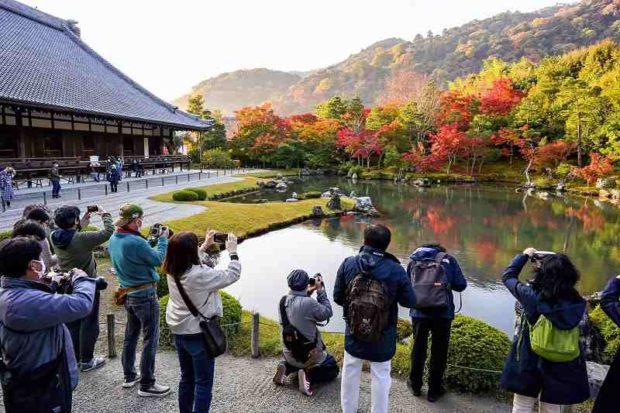
Tourists enjoy viewing autumn leaves illuminated by the morning sun at Tenryuji Temple in Ukyo Ward, Kyoto, on Nov. 12. The Japan News/Asia News Network
KYOTO — Tourists keen to visit Kyoto attractions but equally keen to avoid big crowds are increasingly getting up with the lark to put in a spot of morning sightseeing. With the easing of COVID-19 restrictions and border controls, Kyoto’s temples, shrines and hotels are looking to cash in on these early risers.
A little after 7:30 a.m., about 90 tourists enjoyed looking at the variously colored foliage of maple trees and pines reflecting on the surface of the pond in a garden at Tenryuji temple, a World Heritage site in Kyoto’s Arashiyama district.
The temple is a popular draw and sees an uninterrupted flow of people during the day. However, the early morning visitors were able to soak up the cool air free from hustle and bustle while occasionally snapping photos. A satisfied-looking 36-year-old tourist from Britain said it was “worth getting up early to visit the site.”
The temple is opening at 7:30 a.m. — one hour earlier than usual — through Nov. 30 to coincide with the changing colors of the autumn leaves.
“The beauty of the morning light shining on the garden is exceptional,” a temple official said. “It’s a real must-see experience.”
The trend to encourage morning sightseeing began prior to the coronavirus pandemic as part of measures to ease tourist congestion in Kyoto, which was attracting more than 50 million tourists a year. An economic ripple effect is also expected, as more tourists are motivated to stay overnight in Kyoto in anticipation of morning trips.
The pandemic caused a sharp fall in the number of visitors to Kyoto, with only about 20 million visiting in 2021, but numbers have been recovering since border regulations were eased in October. With the ban on individual travel from abroad now lifted, entry restrictions for foreigners have returned to a pre-pandemic state for the first time in two and a half years. The removal of travel restriction within Japan, too, has also been a major factor.
Footfall on Kyoto municipal buses and subways in the second week of November increased 13% on weekdays and 10% to 16% on weekends compared with the same period last year.
With the gradual return to normality, morning tourism is once again attracting attention, and more and more temples, shrines and others are showcasing various early-hours attractions.
Hoshinoya Kyoto, a Japanese-style inn in Nishikyo Ward, has launched a chartered-boat ride that allows guests to enjoy a special breakfast, which includes venison and mushroom hot pot, while viewing autumnal leaves in a valley. The program, which runs through Dec. 5, is only open to one pair of overnight guests each day, at a total cost of ¥69,000. According to the inn, half the reservation slots are already filled.
“Morning tourism is set to become a model for the novel coronavirus era,” said Yuna Haruhara, who is in charge of public relations at the inn.
Shimogamo Shrine, a World Heritage site in Sakyo Ward, is offering a 9 a.m. weekday tour throughout this month. Participants are shown around the shrine’s ground by a priest and can later enjoy a jelly snack and matcha green tea — made using the shrine’s sacred water — at the Old Mitsui Family Shimogamo Villa, a historic residence. The tour is popular among groups of women on trips lasting two or more days.
Meanwhile, the Kyoto Railway Museum in Shimogyo Ward, offers a tour to view steam trains, including the popular SL Steam locomotive. The tour starts at 9:20 a.m., before the museum opens, and is often fully booked.
Yuna Haruhara, a staffer at Hoshinoya Kyoto inn, speaks about a breakfast boat tour, in the Arashiyama district of Kyoto on Nov. 16. The Japan News/Asia News Network
‘Dispersing’ tourist crowds
With an eye on rebuilding its tourism industry, which has been hit hard by the pandemic, while controlling the spread of infection, the city government of Kyoto has been working on ways to disperse crowds of tourists.
The city government and the Kyoto City Tourism Association use their dedicated website to provide information on centrally located early-bird attractions, as well as spots away from the city center where there are relatively few tourists.
The website also offers a five-level congestion-forecast service for 11 tourist attractions, including Kinkakuji temple (Golden Pavilion) and Fushimi Inari Taisha Shrine. Relevant information can be accessed by inputting the date, time and weather conditions. The same information is available on the Chinese and English sites (https://global.kyoto.travel/en/comfort/).
RELATED STORIES
Kyoto’s love-hate relationship with tourists endures as yen weakens
Foreign visitors in Japan surge after tourism reopening